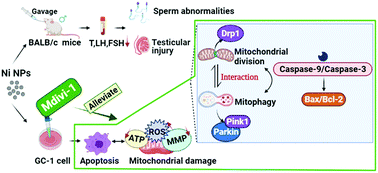Study of the mechanism of mitochondrial division and mitochondrial autophagy in the male reproductive toxicity induced by nickel nanoparticles
Abstract
Male reproductive health is deteriorating, and fertility is largely affected by environmental factors. This study aims to investigate the potential mechanism underlying mitochondrial division and mitochondrial autophagy in the male reproductive toxicity of nickel nanoparticles (Ni NPs). An in vivo mouse (BALB/c) model was constructed to calculate testicular organ coefficients and sperm abnormality rates, and detect serum reproductive hormones, testicular pathological morphology, and the expression of Drp1, Pink1, and Parkin proteins. Furthermore, mouse spermatogonia (GC-1 cells) were used as an in vitro model to detect cell viability, apoptosis, intracellular reactive oxygen species (ROS), mitochondrial membrane potential (MMP), ATP and protein expression. After treatment with an additional inhibitor, Mdivi-1, such influences were further detected to explore the possible mechanism of male reproductive toxicity induced by Ni NPs. The in vivo studies showed that compared with the control group, exposure to Ni NPs reduced the serum levels of testosterone, follicle stimulating hormone and luteinizing hormone, increased the sperm abnormality rate, widened the gaps in the seminiferous tubules of the testes, decreased the sperm count, and increased the expression of Drp1, Pink1 and Parkin proteins (all P < 0.05). The in vitro studies further confirmed that compared with the control group, Ni NPs can lead to decreased cell viability, increased apoptosis, accumulation of ROS, decreased MMP and ATP, increased expression of Drp1, Pink1, Parkin, Bax, caspase-9 and caspase-3 proteins, and decreased expression of Bcl-2, resulting in an increased value of Bax/Bcl-2. It is worth noting that such influences induced by Ni NPs were significantly reversed by the additional Mdivi-1. In conclusion, Drp1-mediated mitochondrial division and Pink1/Parkin-mediated mitochondrial autophagy play an important role in the male reproductive toxicity of Ni NPs, during which both of them form an interaction cycle and accelerate the occurrence of cell apoptosis.



 Please wait while we load your content...
Please wait while we load your content...